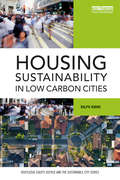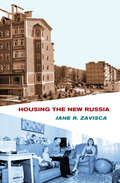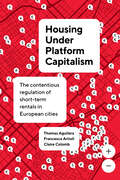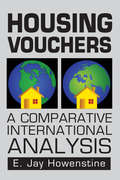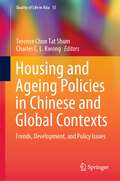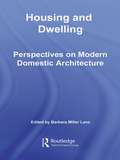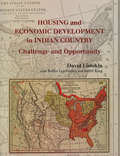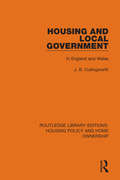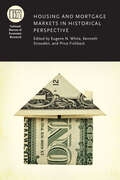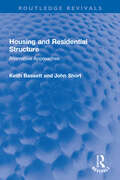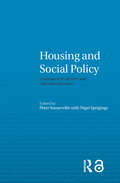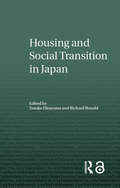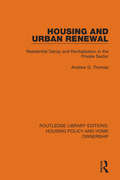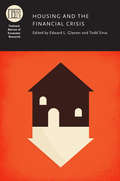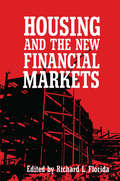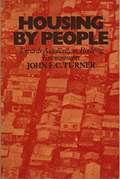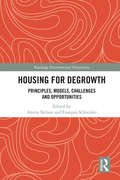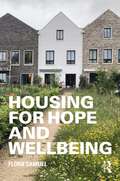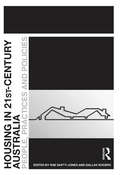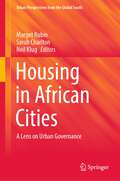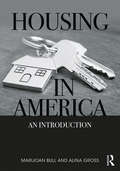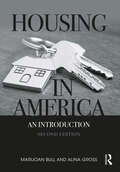- Table View
- List View
Housing Sustainability in Low Carbon Cities (Routledge Equity, Justice and the Sustainable City series)
by Ralph HorneHousing affordability, urban development and climate change responses are great challenges that are intertwined, yet the conceptual and policy links between them remain under-developed. Housing Sustainability in Low Carbon Cities addresses this gap by developing an interdisciplinary approach to urban decarbonisation, drawing upon more established, yet quite distinctive, fields of built environment policy and design, housing, and studies of social and economic change. Through this approach, policy and practices of housing affordability, equity, energy efficiency, resilience and renewables are critiqued and alternatives are presented. Drawing upon international case studies, this book provides a unique contribution to interdisciplinary urban and housing studies, discourses and practices in an era of climate change. This book is recommended reading on higher level undergraduate and taught postgraduate courses in architecture, urban studies, planning, built environment, geography and urban studies. It will also be directly valuable to housing and urban policy makers and sustainability practitioners.
Housing The New Russia
by Jane R. ZaviscaIn Housing the New Russia, Jane R. Zavisca examines Russia's attempts to transition from a socialist vision of housing, in which the government promised a separate, state-owned apartment for every family, to a market-based and mortgage-dependent model of home ownership. In 1992, the post-Soviet Russian government signed an agreement with the United States to create the Russian housing market. The vision of an American-style market guided housing policy over the next two decades. Privatization gave socialist housing to existing occupants, creating a nation of homeowners overnight. New financial institutions, modeled on the American mortgage system, laid the foundation for a market. Next the state tried to stimulate mortgages-and reverse the declining birth rate, another major concern-by subsidizing loans for young families. Imported housing institutions, however, failed to resonate with local conceptions of ownership, property, and rights. Most Russians reject mortgages, which they call "debt bondage," as an unjust "overpayment" for a good they consider to be a basic right. Instead of stimulating homeownership, privatization, combined with high prices and limited credit, created a system of "property without markets. " Frustrated aspirations and unjustified inequality led most Russians to call for a government-controlled housing market. Under the Soviet system, residents retained lifelong tenancy rights, perceiving the apartments they inhabited as their own. In the wake of privatization, young Russians can no longer count on the state to provide their house, nor can they afford to buy a home with wages, forcing many to live with extended family well into adulthood. Zavisca shows that the contradictions of housing policy are a significant factor in Russia's falling birth rates and the apparent failure of its pronatalist policies. These consequences further stack the deck against the likelihood that an affordable housing market will take off in the near future.
Housing Under Platform Capitalism: The Contentious Regulation of Short-Term Rentals in European Cities (IJURR Studies in Urban and Social Change)
by Claire Colomb Thomas Aguilera Francesca ArtioliSince the birth of Airbnb in 2008, many of the world's cities have been transformed by platform-mediated short-term accommodation—a phenomenon suspected of disturbing local life and removing dwellings from local housing inventories. Drawing on mixed-method, multi-level comparative research in twelve large European cities, coauthors Thomas Aguilera, Francesca Artioli, and Claire Colomb show that strikingly different regulatory regimes have emerged around short-term rentals. In some cities, policies aim to curb this practice; in others, regulations are simply meant to support the market. These responses are motivated by a variety of political choices and pressures, from grassroots movements to property interests, the tourism industry, and municipal welfare and housing systems. This book makes a crucial contribution to comparative urban politics in the twenty-first century, investigating the capacity of local states to govern housing markets and platform capitalism in an era of globalized human and capital flows. In the face of this worldwide shift, Housing Under Platform Capitalism insists that institutions and regulations can champion the public good by protecting the right to housing and ultimately limiting corporate power.
Housing Vouchers: A Comparative International Analysis
by E. Jay HowenstineOutside the United States, the idea of a consumer housing subsidy is a highly developed concept. Housing allowances, shelter allowances, rent allowances - or rent rebates as they are called - have been paid out on a larger scale for longer periods of time on an entitlement basis, with a much greater variety of rationales than in the United States. As the United States moves ahead with its demonstration program, it is timely to examine and evaluate foreign experiences with the consumer housing approach.E. Jay Howenstine addresses common questions that have puzzled many policymakers: How do consumer housing subsidies work? For tenants? Homeowners? Builders? And government officials? Gathered here is the definitive experience of the countries that have employed them. From Australia to the United Kingdom, here is the reality gleaned from a dozen countries and brought to bear on the United States. Both the virtues and the limitations of the approach are presented in detail for everyone interested in housing.This study is divided into three major parts. First, Howenstine reviews the historical background and analyzes housing allowance strategies that foreign governments have adopted. A second part examines in detail the major principles and elements with which governments have fashioned their systems. The third part examines the impact of housing allowance systems and weighs them in the light of the original objectives. Conclusions are also drawn about foreign experiences: Should financial assistance to low-income families be in the form of consumer housing subsidies or producer housing subsidies, or some synthesis of the two systems? Should the housing allowance be maintained as a separate housing policy, or should it be integrated into a general income maintenance policy? This book addresses an increasingly prominent portion of the housing market.
Housing and Ageing Policies in Chinese and Global Contexts: Trends, Development, and Policy Issues (Quality of Life in Asia #15)
by Terence Chun Tat Shum Charles C. L. KwongMotivated by the rapid increase in housing demand and the population of older adults worldwide, this book provides an interdisciplinary and multi-level approach for studying housing and ageing issues and relevant policy analysis in China, and beyond. Specifically, it highlights how the changing social, economic, and political factors at both local and global levels affect the housing or ageing experiences of people. Drawing on findings and theoretical discussions in economics, history, psychology, sociology, social policy, and urban studies, the authors offer interdisciplinary perspectives on a highly topical debate, asking what progress is being made on the formulation and implementation of housing and ageing policies in different societies. The book brings together original qualitative and quantitative research works in European, Asia-Pacific and Chinese contexts. Readers will benefit from the results of a rigorous analysis of data and case studies that reveal factors affecting housing or ageing experiences of people in these regions. The interdisciplinary research also provides valuable insights on further policy analyses and formulation in both local and global contexts. It is of interest to scholars, policy makers and university students in the fields of housing, ageing, and social and public policy.
Housing and Dwelling: Perspectives on Modern Domestic Architecture
by Barbara Miller LaneHousing and Dwelling collects the best in recent scholarly and philosophical writings that bear upon the history of domestic architecture in the nineteenth and twentieth centuries. Lane combines exemplary readings that focus on and examine the issues involved in the study of domestic architecture, taken from an innovative and informed combination of philosophy, history, social science, art, literature and architectural writings. Uniquely, the readings underline the point of view of the user of a dwelling and assess the impact of varying uses on the evolution of domestic architecture. This book is a valuable asset for students, scholars, and designers alike, exploring the extraordinary variety of methods, interpretations and source materials now available in this important field. For students, it opens windows on the many aspects of domestic architecture. For scholars, it introduces new, interdisciplinary points of view and suggests directions for further research. It acquaints practising architects in the field of housing design with history and methods and offers directions for future design possibilities.
Housing and Economic Development in Indian Country: Challenge and Opportunity
by Robin LeichenkoAmong America's most complex planning environments, Indian country continues to face innumerable challenges to its community development. These factors are historic in nature, creating an assemblage of complex problems in reservation land management, policy implementation, and the ability of tribes to access capital for community investment.This study explores the history and the land, population, economic, and housing characteristics of Indian country. The authors' investigation includes: reservations, Alaska Native villages, and other Census-recognized areas of historical Native American settlement and tribal culture. They analyze the constraints to housing and economic development and develop strategies for addressing those constraints. This book also identifies, uses, and evaluates data sources relevant to the study of housing and economic development on tribal lands. The research in this book was funded by the Fannie Mae Foundation.In the Journal of the American Planning Association, Nicholas C. Zaferatos wrote that Housing and Economic Development in Indian Country is an essential desk reference for policymakers and planners working in Native American communities, as well as for nontribal agencies and other planners who share a concern for the well-being of tribal nations. It also contains extensive appendices in an accompanying CD containing data for individual tribal areas.
Housing and Interior Design
by Evelyn L. Lewis Carolyn S. TurnerHousing and Interior Design is the perfect choice for introducing students to the fascinating world of housing and interior design. With a striking design and beautiful illustrations, this teaching package helps students examine housing needs and choices, the basic principles of interior design and design presentation, and opportunities in a wide range of housing and interior design careers. In addition, the text: * Examines historical, cultural, and technological influences on housing and interiors. * Addresses architectural styles and housing types along with universal design for all people. * Introduces the elements and principles of design and their indoor and outdoor applications. Also presents the phases of the design process. * Highlights green and sustainable design and ecological issues in the Green Choices features. * Profiles numerous housing and interior design careers in the Career Focus features. * Includes a wealth of chapter review materials that help students apply text concepts, including Think Critically, Community Links, Academic Connections, Technology Applications, Design Practice, and FCCLA.
Housing and Local Government: In England and Wales
by J. B. CullingworthOriginally published in 1966 and written at a time when UK housing policy was undergoing major changes, this volume provides a substantial historical introduction which outlines the development of housing policy in the UK from the mid 19th – mid 20th Centuries. Discussion of the administrative framework, the powers of local housing authorities, housing standards, finance and the improvement of older housing follows. Other issues covered include the social aspects of housing and the role of the state and the objectives of state action.
Housing and Mortgage Markets in Historical Perspective (National Bureau of Economic Research Conference Report)
by Price Fishback Kenneth Snowden Eugene N. WhiteThe central role of the housing market in the recent recession raised a series of questions about similar episodes throughout economic history. Were the underlying causes of housing and mortgage crises the same in earlier episodes? Has the onset and spread of crises changed over time? How have previous policy interventions either damaged or improved long-run market performance and stability? This volume begins to answer these questions, providing a much-needed context for understanding recent events by examining how historical housing and mortgage markets workedOCoand how they sometimes failed. Renowned economic historians Eugene N. White, Kenneth Snowden, and Price Fishback survey the foundational research on housing crises, comparing that of the 1930s to that of the early 2000s in order to authoritatively identify what contributed to each crisis. Later chapters explore notable historical experiences with mortgage securitization and the role that federal policy played in the surge in home ownership between 1940 and 1960. By providing a broad historical overview of housing and mortgage markets, the volume offers valuable new insights to inform future policy debates. "
Housing and Residential Structure: Alternative Approaches (Routledge Revivals)
by John Short Keith BassettFirst published in 1980, Housing and Residential Structure was written to take stock of the many changes that had recently taken place in explanatory approaches to housing markets and residential structure. The book is divided into three parts. Part One focuses on the demand-orientated approaches of human ecology and neo-classical economics. Part Two discusses the institutional approaches with reference to an analysis of private and public sector housing in Britain, drawing on illustrative material from North America and France to aid the comparative analysis of institutional structures. Part Three is devoted to an evaluation of the Marxist approaches to housing and residential structure from Marx and Engels to Castells and Harvey.
Housing and SDGs in Urban Africa (Advances in 21st Century Human Settlements)
by Timothy Gbenga Nubi Isobel Anderson Taibat Lawanson Basirat OyalowoThere is a dearth of collections of scholarly works dedicated wholly to African issues, that comes out of the work done by African scholars and practitioners with both African collaborators and from elsewhere. This volume brings together scholarly works and thoughts that cut across and intertwine the tripods-environment-consciousness, socially just development and African development into options that could deliver on the promise of the SDGs. The book project is an initiative of the Centre for Housing and Sustainable Development at the University of Lagos, which realized the gap in ground research linking the housing sector with the SDGs in African cities. This book therefore presents chapters that explore the interconnections, interactions and linkages between the SDGs and Housing through research, practice, experience, case-studies, desk-based research and other knowledge media.
Housing and Social Policy: Contemporary Themes and Critical Perspectives (Housing and Society Series)
by Peter Somerville Nigel SprigingsThis topical book transforms the analysis of housing problems into a lively, interesting and contentious subject of social scientific study, addressing themes of residential experience, inclusion/empowerment, sustainability and professionalism/managerialism, which lie at the heart of the housing and social policy debate. Each chapter considers a specific social category - such as class, gender, or disability - and evaluates the experience and understanding of housing and social policy under this category. With innovative approaches to conceptualising housing and a clear, defined structure, Housing and Social Policy encourages students and practitioners in both arenas to think reflexively about housing as a central instrument of social policy and social experience.
Housing and Social Transition in Japan (Housing and Society Series)
by Richard Ronald Yosuke HirayamaBringing together a number of perspectives on the Japanese housing system, Housing and Social Transition in Japan provides a comprehensive, challenging and theoretically developed account of the dynamic role of the housing system during a period of unprecedented social and economic change in one of the most enigmatic social, political, and economic systems of the modern world. While Japan demonstrates many of the characteristics of some western housing and social systems, including mass homeownership and consumption-based lifestyles, extensive economic growth and rapid urban modernization has been achieved in balance with traditional social values and the maintenance of the family system. Helpfully divided into three sections, Housing and Social Transition in Japan: explores the dynamics of the development of the housing system in post-war Japan deals with social issues related to housing in terms of social aging, family relations, gender and inequality addresses the Japanese housing system and social change in relation to comparative and theoretical frameworks. As well as providing challenges and insights for the academic community at large, this book also provides a good introduction to the study of Japan and its housing, economic, social and welfare system generally.
Housing and Urban Renewal: Residential Decay and Revitalization in the Private Sector
by Andrew D. ThomasOriginally published in 1986, this book provides an authoritative summary of late 20th Century trends which affected housing stock and a comprehensive commentary on policies which were designed to improve housing stock. The policies referred to are specific to England and Wales but the experience is relevant to other countries facing similar trends: a growth in owner-occupation, increasing problems of disrepair and low levels of investment in the housing stock. It will be on interest to those concerned with levels of investment in older urban areas, with the impact of subsidies on housing tenure, and with the role of government in controlling housing quality.
Housing and the Financial Crisis: Housing And The Financial Crisis (National Bureau of Economic Research Conference Report)
by Edward L. Glaeser Todd SinaiConventional wisdom held that housing prices couldnOCOt fall. But the spectacular boom and bust of the housing market during the first decade of the twenty-first century and millions of foreclosed homeowners have made it clear that housing is no different from any other asset in its ability to climb and crash. aaaaaaaaaaa "Housing and the Financial Crisis "looks at what happened to prices and construction both during and after the housing boom in different parts of the American housing market, accounting for why certain areas experienced less volatility than others. It then examines the causes of the boom and bust, including the availability of credit, the perceived risk reduction due to the securitization of mortgages, and the increase in lending from foreign sources. Finally, it examines a range of policies that might address some of the sources of recent instability.
Housing and the New Financial Mark
by Richard L. FloridaThis book explores how deregulation affect housing finance, and gives the broad patterns of development of institutions participating in mortgage markets. It also explores how the new housing finance system influences the cost and affordability of shelter.
Housing by People: Toward Autonomy In Building Environments
by John F.C. TurnerA unique and timely contribution to housing theory and practice that presents alternative ideas for what has become one of the most pressing of contemporary problems.
Housing for Degrowth: Principles, Models, Challenges and Opportunities (Routledge Environmental Humanities)
by Anitra Nelson François Schneider‘Degrowth’, a type of ‘postgrowth’, is becoming a strong political, practical and cultural movement for downscaling and transforming societies beyond capitalist growth and non-capitalist productivism to achieve global sustainability and satisfy everyone’s basic needs. This groundbreaking collection on housing for degrowth addresses key challenges of unaffordable, unsustainable and anti-social housing today, including going beyond struggles for a 'right to the city' to a 'right to metabolism', advocating refurbishment versus demolition, and revealing controversies within the degrowth movement on urbanisation, decentralisation and open localism. International case studies show how housing for degrowth is based on sufficiency and conviviality, living a ‘one planet lifestyle’ with a common ecological footprint. This book explores environmental, cultural and economic housing and planning issues from interdisciplinary perspectives such as urbanism, ecological economics, environmental justice, housing studies and policy, planning studies and policy, sustainability studies, political ecology, social change and degrowth. It will appeal to students and scholars across a wide range of disciplines.
Housing for Hope and Wellbeing
by Flora SamuelHousing and neighbourhoods have an important contribution to make to our wellbeing and our sense of our place in the world. This book, written for a lay audience (with policy makers firmly in mind) offers a useful and intelligible overview of our housing system and why it is in ‘crisis’ while acting as an important reminder of how housing contributes to social value, defined as community, health, self development and identity. It argues for a holistic digital map-based planning system that allows for the sensitive balancing of the triple bottom line of sustainability: social, environmental and economic value. It sets out a vision of what our housing system could look like if we really put the wellbeing of people and planet first, as well as a route map on how to get there. Written primarily from the point of view of an architect, the account weaves across industry, practice and academia cross cutting disciplines to provide an integrated view of the field. The book focusses on the UK housing scene but draws on and provides lessons for housing cultures across the globe. Illustrated throughout with case studies, this is the go-to book for anyone who wants to look at housing in a holistic way.
Housing in 21st-Century Australia: People, Practices and Policies
by Rae Dufty-Jones Dallas RogersOver the last two decades new and significant demographic, economic, social and environmental changes and challenges have shaped the production and consumption of housing in Australia and the policy settings that attempt to guide these processes. These changes and challenges, as outlined in this book, are many and varied. While these issues are new they raise timeless questions around affordability, access, density, quantity, type and location of housing needed in Australian towns and cities. The studies presented in this text also provide a unique insight into a range of housing production, consumption and policy issues that, while based in Australia, have implications that go beyond this national context. For instance how do suburban-based societies adjust to the realities of aging populations, anthropogenic climate change and the significant implications such change has for housing? How has policy been translated and assembled in specific national contexts? Similarly, what are the significantly different policy settings the production and consumption of housing in a post-Global Financial Crisis period require? Framed in this way this book accounts for and responds to some of the key housing issues of the 21st century.
Housing in African Cities: A Lens on Urban Governance (GeoJournal Library)
by Sarah Charlton Margot Rubin Neil KlugThis edited collection from across the African continent offers a diverse set of analytical accounts that engage with the urban governance dynamics, drivers and impacts of a wide variety of housing initiatives. These include insights into the relationships between parties and actors undertaking developments, or whose housing activities impact on the city. The book illustrates issues of power distribution, the visions or agendas motivating these actions, and the instruments used to advance them. It considers the rise of mega housing projects; private sector driven residential developments; unobtrusive transformations of existing building stock, establishment and upgrading of informal settlements; and state driven low cost housing schemes. It surfaces the contestation, collaborations and conflicts as well as the power relations that operate within cities and which are made visible on cityscapes. Housing and human settlement scholars as well as those interested in urban politics and governance dynamics in the global south and across the African continent will find much to appreciate in this volume.
Housing in America: An Introduction
by Marijoan Bull Alina GrossHousing is a fundamental need and universal part of human living that shapes our lives in profound ways that go far beyond basic sheltering. Where we live can determine our self-image, social status, health and safety, quality of public services, access to jobs, and transportation options. But the reality for many in America is that housing choices are constrained: costs are unaffordable, discriminatory practices remain, and physical features do not align with needs. As a society, we recognize the significant role housing plays in our overall quality of life and the stability of our communities. We have made a national commitment to decent housing for all yet this promise remains unrealized. Housing in America provides a broad overview of the field of housing, with the objective of fostering an informed and engaged citizenry. The evolution of housing norms and policy is explored in a historical context while underscoring the human and cultural dimensions of housing program choices. Specific topics covered include: why housing matters; housing and culture; housing frameworks and political ideologies; housing and opportunities; housing and the economy; housing discrimination; and housing affordability. Readers will gain an understanding of the basic debates within the field of housing, consider the motivations and performance of various interventions, and critically examine persistent patterns of racial and class inequality. With an exploration of theoretical frameworks, short case studies, reflective exercises, and strong visuals, this introductory text explores improving housing choices in America.
Housing in America: An Introduction
by Marijoan Bull Alina GrossHousing is a fundamental need and universal part of human living that shapes our lives in profound ways that go far beyond basic sheltering. Where we live can determine our self-image, social status, health and safety, quality of public services, access to jobs, and transportation options. But the reality for many in America is that housing choices are constrained: costs are unaffordable, discriminatory practices remain, and physical features do not align with needs. We have made a national commitment to decent housing for all, yet this promise remains unrealized. Housing in America provides a broad overview of the field of housing. The evolution of housing norms and policy is explored in a historical context while underscoring the human and cultural dimensions of housing program choices. Specific topics covered include: why housing matters; housing and culture; housing frameworks and political ideologies; housing and opportunities; housing and the economy; housing discrimination; housing affordability; rental housing; and housing and climate change. Readers will gain an understanding of the basic debates within the field of housing, consider the motivations and performance of various interventions, and critically examine persistent patterns of racial and class inequality. With short case studies, primary source materials, reflective exercises, strong visuals, and interviews with practitioners, this introductory text explores improving housing choices in America.
